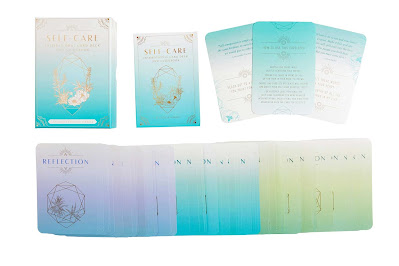Gratitude: Inspirational Card Deck and Guidebook by Caitlin Scholl
, 31 December 2021
THINGS I LOVE
> Caitlin Sholl's texts and the advice given are terrific. The author guides us and allows us to deep dive into gratitude with prompts to make us find things we are grateful for, and tips on how to express gratitude. Scholl's definition of and introduction to gratitude are wonderful and very unique.
> The deck structure. The cards are organised in three sections and energies: 1/ Affirmation, connected to the morning. 2/ Inspiration, connected to midday. 3/ Reflection, connected to the evening. They have three different coding colours (yellow, green and violet) and each card comes with an inspiration quote at the top, and some items of advice to follow on the day, plus the extended advice in the guidebook.> Caitlin Sholl's texts and the advice given are terrific. The author guides us and allows us to deep dive into gratitude with prompts to make us find things we are grateful for, and tips on how to express gratitude. Scholl's definition of and introduction to gratitude are wonderful and very unique.
> The overall pastel colour scheme and the whole visual design of the deck, which is minimalist and very elegant.
> The plush deck bag, which is an awesome bonus.
> The quality of the cards and the fact that they shuffle well.
> You can use just the cards or just the booklet without missing anything.
> You can use the different sections at different times of the day or shuffle all of them at once. In that regard, the deck is very versatile.
> The booklet is printed in good quality glossy paper and is bound loosely so you can open it comfortably.
> Good value for money.
NOT SO GOOD> The contrast between the background and the lettering is deficient overall, but especially noticeable in the yellow set.
> The booklet's deficiencies are unforgivable:
-- The binding is just lightly glued. I was just gently browsing the booklet and two came off unglued from the bottom. Can you imagine if I use this properly?
-- The cards aren't numbered, so the awesome extra information on each card has to be looked up in the guidebook manually, just within the corresponding section. As the cards are made to shuffle, this look-up can be a bit labyrinthine, time consuming and not very helpful. I find surprising that the editorial house didn't pay attention to something so important for a guidebook, because, otherwise, it's not a guide, it's a book where to search for information.
-- The index is too generic to be of any use.
-- The cover is just paper, not even a bit of cardboard to hold the whole thing together.
-- This being the case, I feel hesitant to gift someone with this deck, even though I think this is just a wonderful deck.
> I can use just the booklet or just the cards, not both combined for the reasons mentioned above.
> The booklet's deficiencies are unforgivable:
-- The binding is just lightly glued. I was just gently browsing the booklet and two came off unglued from the bottom. Can you imagine if I use this properly?
-- The cards aren't numbered, so the awesome extra information on each card has to be looked up in the guidebook manually, just within the corresponding section. As the cards are made to shuffle, this look-up can be a bit labyrinthine, time consuming and not very helpful. I find surprising that the editorial house didn't pay attention to something so important for a guidebook, because, otherwise, it's not a guide, it's a book where to search for information.
-- The index is too generic to be of any use.
-- The cover is just paper, not even a bit of cardboard to hold the whole thing together.
-- This being the case, I feel hesitant to gift someone with this deck, even though I think this is just a wonderful deck.
> I can use just the booklet or just the cards, not both combined for the reasons mentioned above.
MIND
The cards are on the large side, so if you, like me, have small hands, you might struggle with the shuffling.
The cards are on the large side, so if you, like me, have small hands, you might struggle with the shuffling.
WISH
I would love seeing the booklet properly reprinted and edited.














































